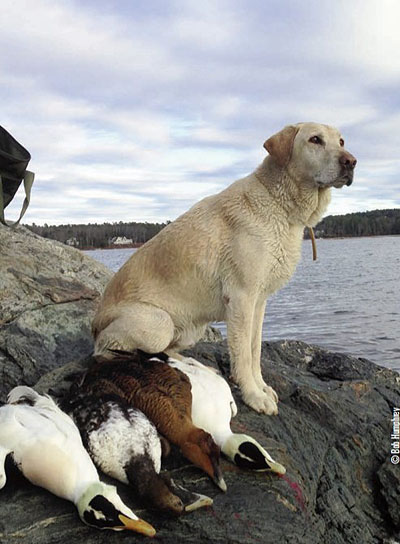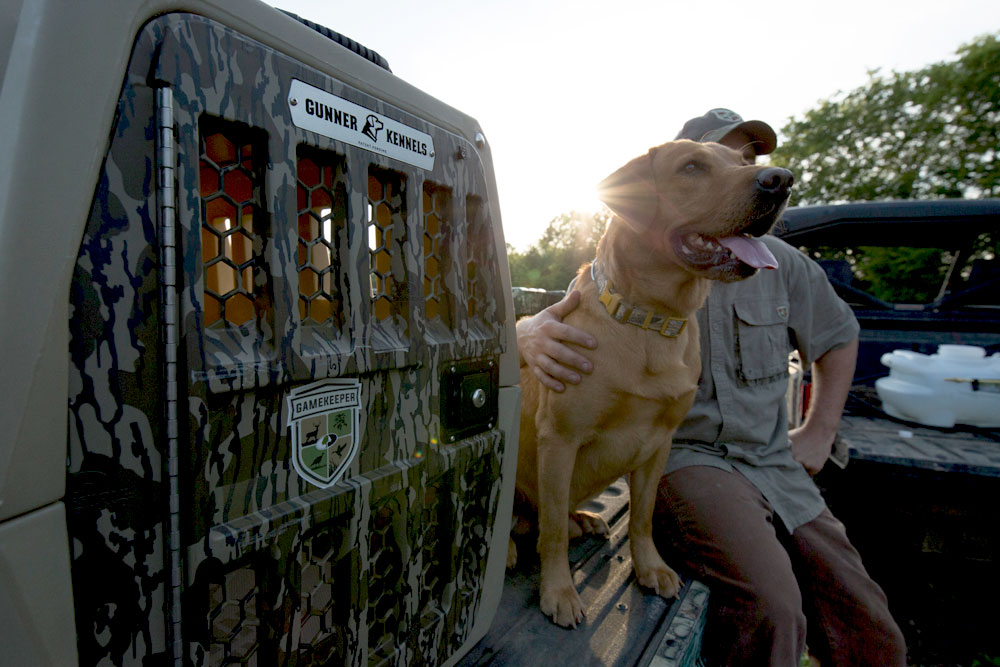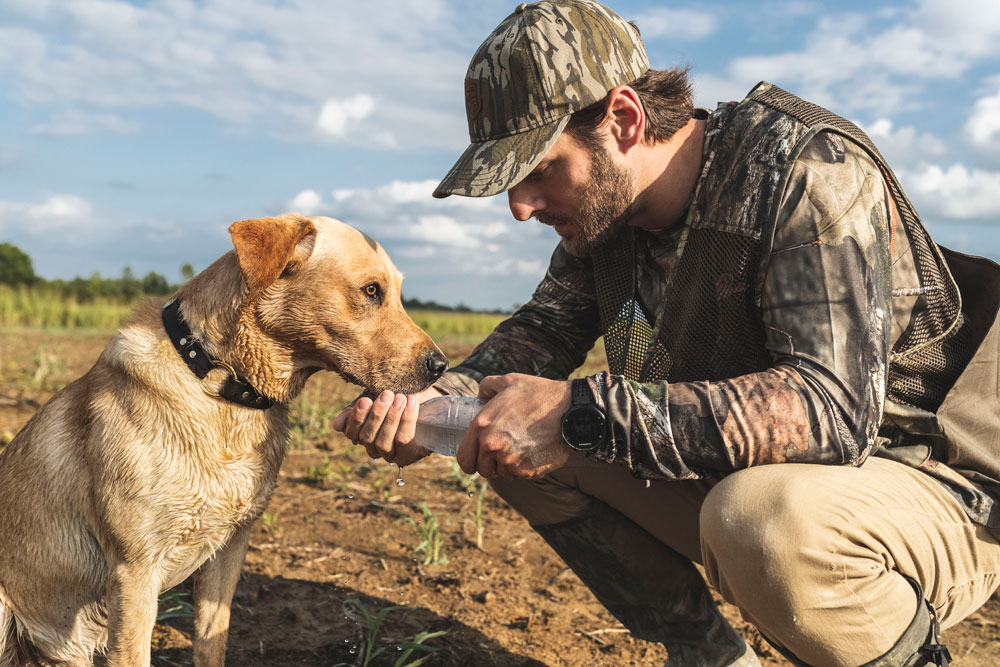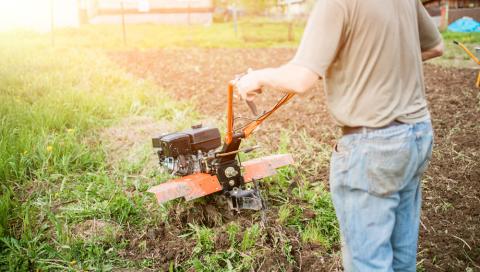Bob Humphrey | Originally published in GameKeepers: Farming for Wildlife Magazine. To subscribe, click here.

safe while afield.
When the first eider came down the shoreline, my hunting partner, Jim, folded the big bird neatly. It hit the water with a tremendous splash then, as so often happens with these rugged oceanic ducks, righted itself and began swimming away. Meanwhile, my lab, Jack was off at the shot, and by the time Jim realized a follow-up shot was needed, it was too late.
The situation took a more serious turn as the bird led Jack farther from shore, swimming downwind and with the tide. Each time Jack closed nearly within reach, the bird would dive and then resurface again, drawing him farther out toward the open ocean. In his single mindedness of purpose, Jack was oblivious to the peril, as well as my whistle blasts and increasingly urgent cracked-voice shouts. All the while, his little black head, riding just above the waves, grew smaller and smaller. My heart and mind raced. I had never experienced such a feeling of helplessness before in my life. I had to do something, but what?
Man’s Best Friend
In addition to yourself, you also want to keep your best friend and four-legged hunting partner safe from a plethora of potential perils they could encounter in and while traveling to and from the field. What follows are some of the more important steps in hunting dog safety.
General Health
An ounce of prevention is worth a pound of cure and some of what you can do to keep your pet safe is common sense and often mandatory. For example, keep them up to date with a regimen of shots, pills, sprays and powders for things like rabies and distemper, fleas, ticks and heartworm. You get these at routine, annual visits to the vet, where they’ll also examine the overall health of your dog. And if they don’t do it, keep your dog’s nails trimmed and their ears clean.
Training
In addition to teaching them to do what you want, training also offers some health and safety benefits for your dog. First, regular pre-season training gets your dog in shape. At best, an out of shape dog leads to frustration. At worst, it invites potential health risks like exhaustion, injury or worse. Just as important, training teaches hunting dogs /our-obsession/blogs/how-to/how-to-keep-your-hunting-dog-in-shape-during-off-season to follow your commands. They don’t understand there may be times when it’s dangerous to take off after a hot scent, rush into a thicket to flush or charge after a downed duck. An overzealous dog could get lost or stolen. In some areas, coyotes, wolves and other predators are becoming an increasing problem. And there are countless other unanticipated possibilities. The opening passage is a prime example. I failed in adequately training my lab to be steady at the shot. While no one wants to waste a bird, it’s better than losing a dog. And I’ve heard more than one story of unsteady dogs bolting from a pit blind and into the line of fire.
Gear
In addition to the usual collars, leads and whistles, there are some other things you should bring along while afield. One is water, to prevent dehydration, especially if it’s in short supply where you hunt. If it’s really hot and dry, you might also give them an electrolyte solution. Another is a first aid kit. You can find much of what you need in your own first aid kit but there are a number of kits available specifically for gun dogs. You may also want to carry some bulky bandages, Benadryl, triple antibiotic, mineral oil, some type of sticky, stretchy wrap and super glue for a quick field fix on cuts. Obviously, you should follow up any injury with your vet. Another item worth strong consideration is a vest. A simple orange cloth vest provides increased visibility, which is a plus in thick cover. More rugged material also provides protection from briars, barbed wire and other sharp objects. Neoprene vests provide flotation and warmth.

Transportation
One area that is often taken for granted, but rife with potential problems is how you transport your dog to and from the field. Who among us hasn’t simply loaded the dog into the back of a pick-up bed and hit the road? There, they’re exposed to wind, cold and flying objects, to name just a few things. An enclosed cap provides some protection, but must be properly ventilated, and locked to prevent theft while you’re having breakfast or picking up some shotgun loads. A far better option is a crate, secured to your bed or the back of your SUV or side-by-side.
I.D.
There’s a reason why you’re city or town requires you to register your pet, and it’s not just to make money. It can help in the recovery of a lost dog. In addition to basic dog tags you might consider an ID tag on their collar with your phone number. Other, more expensive options include tracking collars, microchips and tattoos, but you’ll still want that ID tag.

Back to Jack
As my lab swam farther out toward open ocean in pursuit of the downed eider I looked desperately up and down the shoreline for some solution. I couldn't bear to just stand there and watch my friend drown. Then, I noticed a small pram and raced toward it as quickly as I could, clad in heavy insulated clothing. It was frozen hard to the ground, so like a defensive lineman, , I took two steps and plowed into the pram with my shoulder. We both overturned and my mid-section crashed down on the far side gunwale, knocking the wind out of me. Valuable seconds were lost as I fought to catch what little breath I had. Then, I grabbed the rope, which was tied to the bow, and started to haul the pram away. The rotten line snapped, sending me tumbling to the ground again. It was then I realized the futility of what I was doing. As I lay there on the ground, panting and sweating profusely in the near zero temperatures, I could hear Jim's pleading calls to Jack. Then his tone had changed. I raced back to the shoreline in time to see that little black head getting bigger. Somehow Jack had reached deep down inside and found the strength to swim nearly a quarter of a mile back, into the wind and against the current. When I reached the water’s edge, Jack's feet were just touching bottom. Somehow in his meager brain, I believe he knew how close he had come to death, for his tail was wagging before he cleared the water. I think he was as glad to see me as I to see him. I subsequently took dog safety a lot more seriously.
To learn more about this and other first aid products go to: www.readydogproducts.com.































